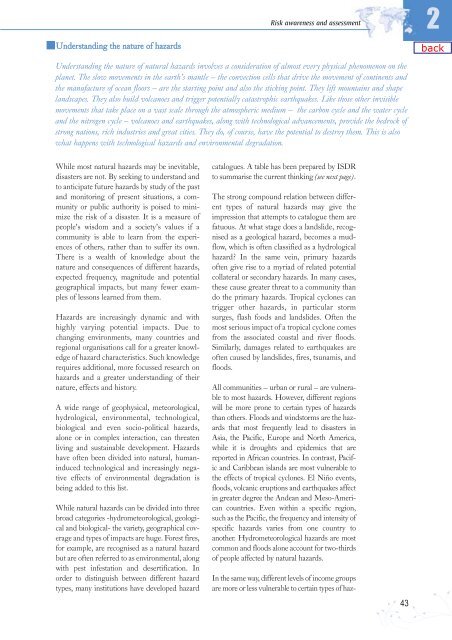Living with Risk. A global review of disaster reduction initiatives
Living with Risk. A global review of disaster reduction initiatives
Living with Risk. A global review of disaster reduction initiatives
Create successful ePaper yourself
Turn your PDF publications into a flip-book with our unique Google optimized e-Paper software.
Understanding the nature <strong>of</strong> hazards<br />
<strong>Risk</strong> awareness and assessment<br />
2<br />
Understanding the nature <strong>of</strong> natural hazards involves a consideration <strong>of</strong> almost every physical phenomenon on the<br />
planet. The slow movements in the earth’s mantle – the convection cells that drive the movement <strong>of</strong> continents and<br />
the manufacture <strong>of</strong> ocean floors – are the starting point and also the sticking point. They lift mountains and shape<br />
landscapes. They also build volcanoes and trigger potentially catastrophic earthquakes. Like those other invisible<br />
movements that take place on a vast scale through the atmospheric medium – the carbon cycle and the water cycle<br />
and the nitrogen cycle – volcanoes and earthquakes, along <strong>with</strong> technological advancements, provide the bedrock <strong>of</strong><br />
strong nations, rich industries and great cities. They do, <strong>of</strong> course, have the potential to destroy them. This is also<br />
what happens <strong>with</strong> technological hazards and environmental degradation.<br />
While most natural hazards may be inevitable,<br />
<strong>disaster</strong>s are not. By seeking to understand and<br />
to anticipate future hazards by study <strong>of</strong> the past<br />
and monitoring <strong>of</strong> present situations, a community<br />
or public authority is poised to minimize<br />
the risk <strong>of</strong> a <strong>disaster</strong>. It is a measure <strong>of</strong><br />
people’s wisdom and a society’s values if a<br />
community is able to learn from the experiences<br />
<strong>of</strong> others, rather than to suffer its own.<br />
There is a wealth <strong>of</strong> knowledge about the<br />
nature and consequences <strong>of</strong> different hazards,<br />
expected frequency, magnitude and potential<br />
geographical impacts, but many fewer examples<br />
<strong>of</strong> lessons learned from them.<br />
Hazards are increasingly dynamic and <strong>with</strong><br />
highly varying potential impacts. Due to<br />
changing environments, many countries and<br />
regional organisations call for a greater knowledge<br />
<strong>of</strong> hazard characteristics. Such knowledge<br />
requires additional, more focussed research on<br />
hazards and a greater understanding <strong>of</strong> their<br />
nature, effects and history.<br />
A wide range <strong>of</strong> geophysical, meteorological,<br />
hydrological, environmental, technological,<br />
biological and even socio-political hazards,<br />
alone or in complex interaction, can threaten<br />
living and sustainable development. Hazards<br />
have <strong>of</strong>ten been divided into natural, humaninduced<br />
technological and increasingly negative<br />
effects <strong>of</strong> environmental degradation is<br />
being added to this list.<br />
While natural hazards can be divided into three<br />
broad categories -hydrometeorological, geological<br />
and biological- the variety, geographical coverage<br />
and types <strong>of</strong> impacts are huge. Forest fires,<br />
for example, are recognised as a natural hazard<br />
but are <strong>of</strong>ten referred to as environmental, along<br />
<strong>with</strong> pest infestation and desertification. In<br />
order to distinguish between different hazard<br />
types, many institutions have developed hazard<br />
catalogues. A table has been prepared by ISDR<br />
to summarise the current thinking (see next page).<br />
The strong compound relation between different<br />
types <strong>of</strong> natural hazards may give the<br />
impression that attempts to catalogue them are<br />
fatuous. At what stage does a landslide, recognised<br />
as a geological hazard, becomes a mudflow,<br />
which is <strong>of</strong>ten classified as a hydrological<br />
hazard? In the same vein, primary hazards<br />
<strong>of</strong>ten give rise to a myriad <strong>of</strong> related potential<br />
collateral or secondary hazards. In many cases,<br />
these cause greater threat to a community than<br />
do the primary hazards. Tropical cyclones can<br />
trigger other hazards, in particular storm<br />
surges, flash foods and landslides. Often the<br />
most serious impact <strong>of</strong> a tropical cyclone comes<br />
from the associated coastal and river floods.<br />
Similarly, damages related to earthquakes are<br />
<strong>of</strong>ten caused by landslides, fires, tsunamis, and<br />
floods.<br />
All communities – urban or rural – are vulnerable<br />
to most hazards. However, different regions<br />
will be more prone to certain types <strong>of</strong> hazards<br />
than others. Floods and windstorms are the hazards<br />
that most frequently lead to <strong>disaster</strong>s in<br />
Asia, the Pacific, Europe and North America,<br />
while it is droughts and epidemics that are<br />
reported in African countries. In contrast, Pacific<br />
and Caribbean islands are most vulnerable to<br />
the effects <strong>of</strong> tropical cyclones. El Niño events,<br />
floods, volcanic eruptions and earthquakes affect<br />
in greater degree the Andean and Meso-American<br />
countries. Even <strong>with</strong>in a specific region,<br />
such as the Pacific, the frequency and intensity <strong>of</strong><br />
specific hazards varies from one country to<br />
another. Hydrometeorological hazards are most<br />
common and floods alone account for two-thirds<br />
<strong>of</strong> people affected by natural hazards.<br />
In the same way, different levels <strong>of</strong> income groups<br />
are more or less vulnerable to certain types <strong>of</strong> haz-<br />
43

















